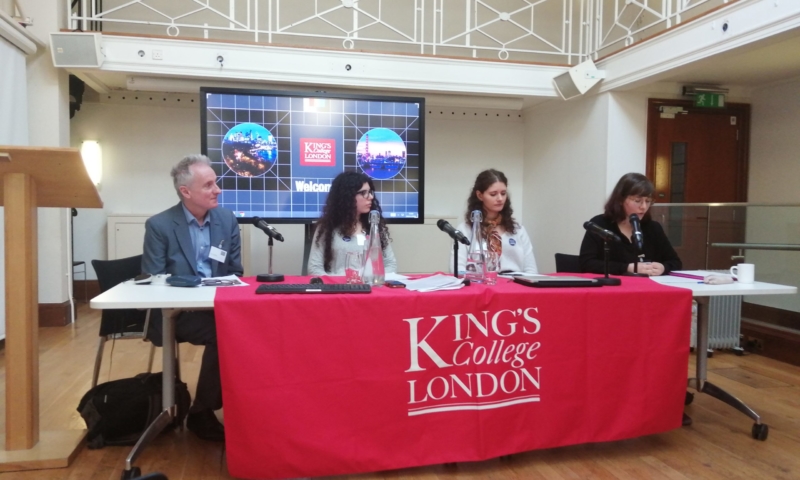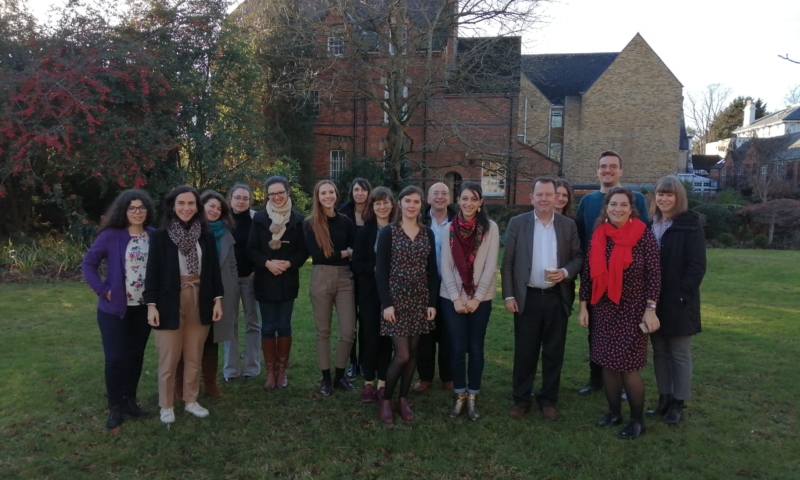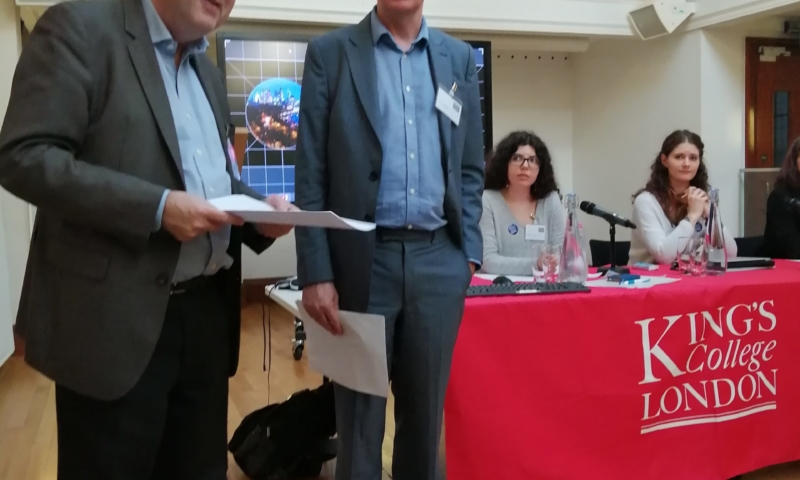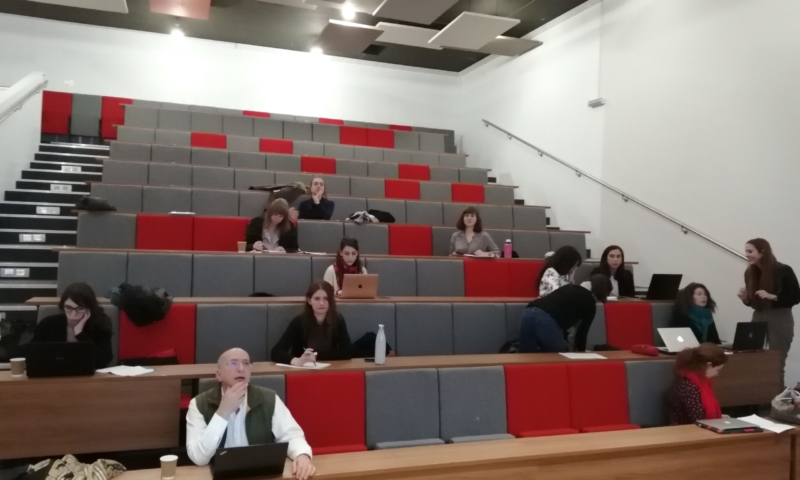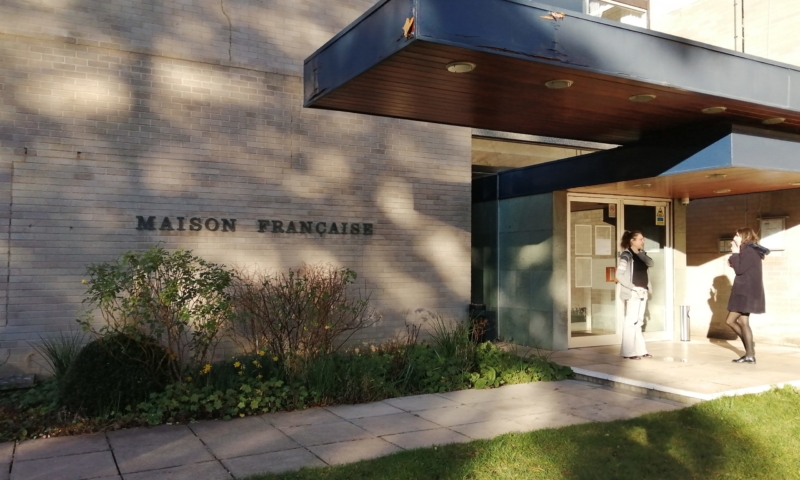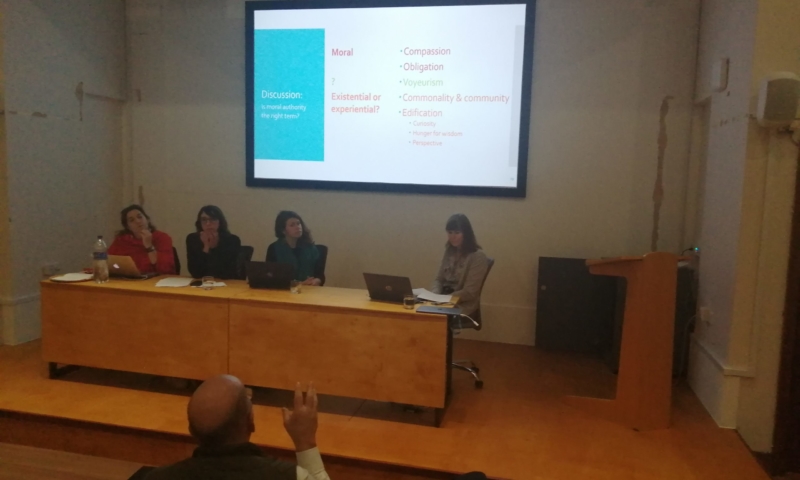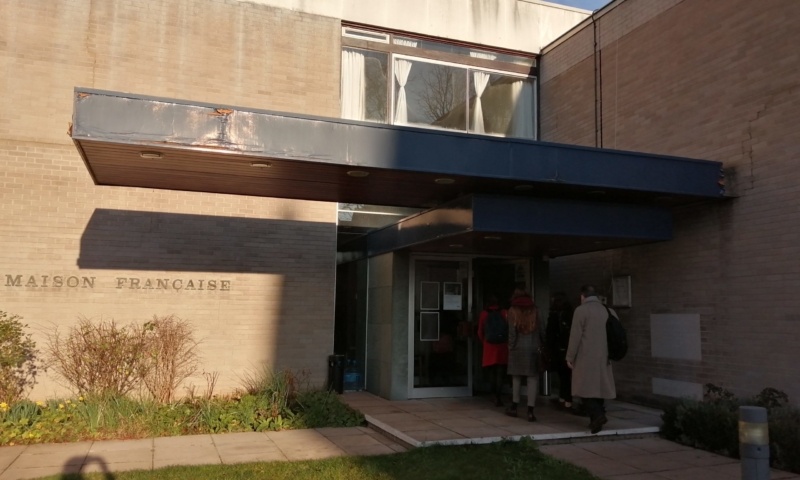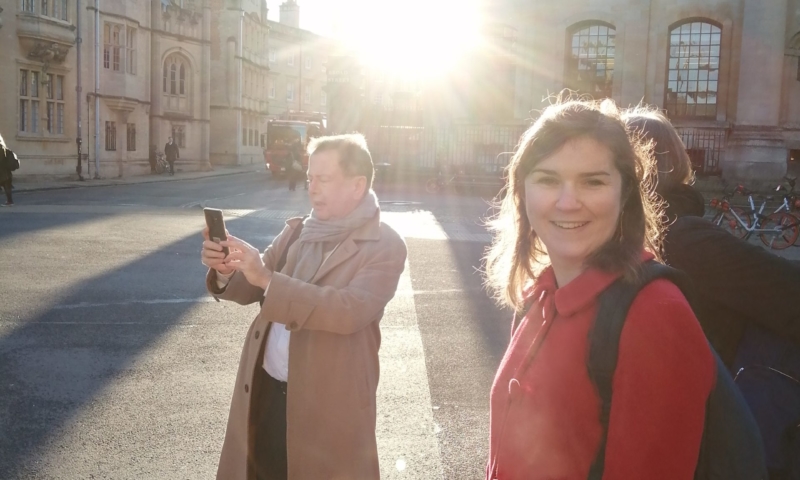King’s College de Londres (9 janvier) et Maison Française d’Oxford (10 janvier)
L’International Research Network (IRN) en humanités médicales du CNRS organise une première rencontre internationale les 9 et 10 janvier 2020 au King’s College de Londres et à la Maison Française d’Oxford, deux journées sur l’expérience de la maladie, spécifiquement destiné aux doctorants et post-doctorants du réseau.
The French National Centre for Scientific Research (CNRS) has set up an International Research Network (IRN) in the medical humanities, bringing together 11 higher education research institutions in France and further afield.[1] It is organising a two-day meeting in London and Oxford on the 9th and 10th of January 2020, specifically aimed at PhD students and postdocs in the network.
The scientific goal of the meeting is twofold. First, starting off from the idea that qualitative and quantitative research can be complementary, we want to consider the ways in which the relationship between qualitative and quantitative research on illness experience has shaped our notions of the case, the person and the cohort in medicine. Second, we want to consider changes that have occurred in the representation of the patient’s voice through new discursive, social and performative practices, over the last 30 or 40 years – at least since the publication of Jay Katz’s famous book, The Silent World of Doctor and Patient (1984).
To explore these ideas and to reinforce the comparative dimension linking the IRN”s French-speaking and the English-speaking arms, papers of 20 minutes maximum are invited on any of the following topics:
- The limits of illness narrative
- The case and the person
- The lived experience of so called ‘imaginary’ illnesses (e.g. CFS)
- Narrating psychological disturbance
- Illness and autofiction
- Neurology as the master discipline in today’s medicine
[1] The CNRS itself, University of Paris 3 (Sorbonne Nouvelle), the University of Montpellier, University of Strasbourg, King’s College London, Durham University, Geneva University, Lisbon University, Montreal University, Columbia University.
Programme
January 9th – Anatomy Museum, Strand Campus, King’s College, London
10.30 AM Welcome and Introduction
Moderation : Neil Vickers
Session 1 – Litterature on medicine and illness or litterature as medicine ? (1)
11 AM – Mariana Baptista (Lisbonne) : « The meaning of Narrative Medicine and Medical Humanities : evidence from a scoping review of the literature in North America and Europe »
11.30 AM – Camille Stidler (CRP 19, Sorbonne Nouvelle) : « La représentation de la santé dans l’oeuvre d’Émile Zola : le cas de Germinal »
12 AM – Claire Jeantils (THALIM, Sorbonne Nouvelle) : « La crise d’épilepsie et son récit »
Lunch Break
Session 2 – Litterature on medicine and illness or litterature as medicine ? (2)
2.30 PM – Christina Lee (King’s College) : « Beyond Pathography : Healing Narratives and the Meditative Turn »
3. PM – Charlotte Wu (King’s College) : « Illness in the body social : ‘Disease narrative’ as a form of national auto-fiction »
3.30-3.45 PM Coffee Break
Session 3 – The resources of narrative
3.45 PM – Rebecca Rosenberg (King’s College) : « Linda Lê’s narratives of psychological disturbance »
5.15 PM – Annaëlle Touboul (THALIM, Sorbonne Nouvelle) : « Histoires de fous. How fiction could nurse psychiatry »
January 10th – MFO, Oxford
Moderation : Marie Gaille
Session 1 – « Experiences »
10. AM – Bénédicte Prot (Oxford) : « La question de l’expérience de la maladie au XVIIIe siècle »
10.30 AM – Sacheenie Moodeley (Oxford) : « On Understanding How Some Teenagers Experience HIV-positive Pregnancy »
11.-11.15 AM coffee break
11.15 AM – Mathilde Lancelot (SPHERE, Paris Diderot) : « Du cérébrocentrisme à l’expérience vécue de patients atteints d’une pathologie neurodégénérative »
11.45 AM – Cherie Henderson (Columbia University) : « Having the Last Words : Brittany Maynard and the Moral Authority of the Terminally Ill »
Lunch Break
Moderation : Carle Bonafous-Murat
Session 2 – Writing about oneself
2. PM – Marie Bonnot (THALIM, Sorbonne Nouvelle) : « Le cas du rêveur »
2.30 PM – James Rakoczi (King’s College) : « Therapeutics and the Writing Self : Or, thinking neurologically with Merleau-Ponty in six steps »
3. PM – Carla Robison (King’s College) : « Siri Hustvedt’s the shaking woman’ (2010) : Je est un autre or the Heteroglossic Illness Narrative »
3.30-3.45 PM Coffee Break
Session 3 : Convergent, complementary or irreconciable perspectives ?
3.45 PM – Clémence Guillermain (SPHERE, Paris Diderot) : « Vision biologique et expérience subjective du vieillissement »
4.15 PM – Joana Correa Monteiro (Lisbonne) : « Doctors and moral philosophers »
4.45 PM – Christine Leroy (Paris 1 Panthéon Sorbonne, ACTE) : « Écriture de l’anorexie mentale en première personne et changement de paradigme médical »
Résumés des intervenants
Marie BONNOT (THALIM, Paris Sorbonne-Nouvelle) : Soi-même comme un cas : à propos de quelques pratiques d’auto-observation onirique (Breton, Queneau, Leiris, Michaux)
Si le rêve n’est pas une pathologie à proprement parler, il est volontiers perçu comme le symptôme d’un trouble, d’un malaise, d’un dysfonctionnement, voire d’une souffrance psychique, et plus particulièrement encore depuis la diffusion de la théorie freudienne. Plusieurs écrivains français du XXe siècle se sont essayés au difficile exercice du récit de rêve authentique, qui puise au cœur de l’expérience onirique et tente de la raconter. Parmi eux, certains comme André Breton, Raymond Queneau, Michel Leiris et Henri Michaux ont tenté d’en faire un outil au service de l’auto-analyse, ou du moins de l’introspection. Dans ces pratiques d’auto-observation onirique, les auteurs s’attachent à examiner leurs rêves, en décortiquent le contenu et risquent une interprétation personnelle.
Dans Les Vases communicants (1932, Breton), Façons d’endormi, façons d’éveillé (1969, Michaux), ou encore dans leurs Journaux (Leiris et Queneau), les littérateurs s’inspirent des procédures psychanalytiques d’analyse du rêve mais éprouvent aussi les limites de l’application au cas individuel d’une grille interprétative. On observe l’émergence, entre leurs lignes, de la voix non seulement d’analysants mais encore d’écrivains singuliers, mettant en place leurs propres réseaux d’images et de significations.
Que peut transmettre le récit d’une telle expérience ? Quelles procédures herméneutiques les écrivains mettent-ils en œuvre ? Se considèrent-ils comme des cas exceptionnels ou comme des exemples d’application ? Quelles limites éprouvent-ils, dans cette entreprise, aussi bien au niveau du récit, que de l’auto-analyse ? C’est à ces questions que nous tenterons de répondre, en partant de l’examen des textes laissés par les auteurs.
Mariana BAPTISTA (Universidade de Lisboa), projet SHARE – Health and Humanities Acting Together : The meaning of Narrative Medicine and Medical Humanities: evidence from a scoping review of the literature in North America and Europe
The interest in ‘narrative’ and ‘humanities’ for health training, research and care delivery has been growing among countries and professions. However, not always their assumptions and uses are clear or easy to understand. Such lack of clarity is not entirely new in the debate as the more stablished definitions of ‘Narrative Medicine’ (NM) and ‘Medical Humanities’ (MH) have neither provided precise information about the interconnections of their boundaries: do they overlap, complement or are independent of each other?
In sum, these questions reveal the need for further analysis of the content, assumptions and boundaries of the designations involving ‘narrative’ and ‘humanities’ in health, and it should be noted that this need is greater as these designations become more popular in the health research and practice.
The aim of this study is to contribute to this debate. It builds on comparing the NM and MH through a scoping review of the literature in North America and Europe with the aim of better understand their meanings and practices from a comparative perspective. The analysis includes quantitative and qualitative approaches on the number, type and content of the publications.
The results are explored to provide a clear definition of NM and MH based on their assumptions and practical uses. To do so, NM and MH are compared in terms of epistemic assumptions, conceptual frameworks and core features of their practice.
Katharine CHESTON (Durham University), The case of CFS: Imaginative responses to “imaginary” illness
Chronic Fatigue Syndrome (CFS) is an undeniably controversial condition. With no diagnostic test for the syndrome, those who live with CFS must contend not only with their symptoms – which include chronic pain, gastrointestinal disturbances and dizziness, alongside the obvious fatigue – but also with the burden of public opinion, as their condition is regularly dismissed as ‘imaginary’. As a result, many with CFS feel that their lived experiences remain unheard.
This paper aims to address this lacuna, focusing in on the voices of those with CFS and the imaginative and creative means through which they express their lived experience of the condition. Taking a literary studies approach, I draw on three texts that are yet to receive critical attention: Julie Rehmeyer’s Through the Shadowlands (2017), Nasim Marie Jafry’s The State of Me (2008) and Laura Hillenbrand’s essay ‘A Sudden Illness’, published in The New Yorker in 2003. Spanning three distinct genres – memoir, autofiction, and essay – the combination of these texts permits an in-depth interrogation of the unique ways of narrating experiences of an illness for which no biomedical narrative and associated scientific vocabulary presently exists. I argue that imaginative and figurative language, in particular metaphor, are central to these texts, and can reveal aspects of the lived experience of CFS that may otherwise go unexpressed. By investigating whether metaphorical language has a particular power to, so to speak, explain the unexplained, this paper builds upon current research in the medical humanities, such as Susannah Mintz’s call to investigate illness in, rather than as, metaphor (2013, p. 13).
In its examination of these eloquent metaphorical expressions and their significance, this paper probes beneath the controversy to illuminate the individual lived experience within the controversial ‘case’ of CFS.
Clémence GUILLERMAIN (SPHERE, Université Paris Diderot) : Vision biologique et expérience subjective du vieillissement
The purpose of this paper is to present part of my PhD project, which I am currently carrying out in philosophy of science, under the direction of Marie Gaille, within the UMR SPHère (UMR 7219). The broad orientation of my thesis is above all epistemological and conceptual. Its first aim is to understand the orientations of contemporary research on ageing and the onset of death, and thus to highlight the conceptions and representations of ageing constructed and conveyed by the life sciences and clinical practice. Its second objective is to put this biological and clinical vision of ageing into perspective with a philosophical questioning of the nature of ageing, as well as with the lived (individual and subjective) experience of ageing.
In this presentation, I will focus on my analysis of the biology of aging. It will be divided into two main parts.
In the first part, I will briefly present my methodology. More specifically, I will show the way I performed not only a broad review of the biological, clinical and philosophical literature published on ageing, but also an “observation field” in a biology unit studying aging in Drosophila, as well as a series of “free” interviews with aging biologists. I will then emphasize three methodological points of interest. First, I will explain how I structured my analysis of the biology of aging, using Ludwik Fleck’s famous book Genesis and Development of a Scientific Fact (Fleck, 1934). Second, I will describe how the “observation field” I performed in a biology unit (more specifically the many interactions I had with specialists of this field) enabled me to build a relevant corpus of articles, accurately representing research in contemporary biology of aging. Third, I will highlight the advantages of having performed “free” interviews with aging biologists. In particular, I will show how such interviews helped me identify some “loose concepts” (see Ilana Löwy, 1992; Evelyn Fox Keller, 1995), “images” or “metaphors” (see Andrew Reyolds, 2018) circulating in the biology of aging.
The second part will be focused on one of these “metaphors”, as I will try and evaluate whether the notion of “wear and tear” is relevant to describe the physiological / biological process of aging.
First, I will show how widely this notion is used to describe aging, both in the everyday life and among various academic fields. Second, I will evaluate its role in the biology of aging: not only is there, indeed, a “wear and tear” theory among the biological theories of aging (Kunlin Jin, 2010), I also believe that some physiological “symptoms” of aging could be interpreted as a form of wear of the organism. Third, I will confront these findings with the discourse of aging biologists to show that this notion is not unanimously accepted. Following one of these specialists’ comment, I will wonder whether this notion is to be considered as an example of “reinvestment of old pre-scientific ideas” (Fleck, 1934). Finally, I will try and evaluate the relevance of such a notion / image / metaphor in contemporary aging biology.
Claire JEANTILS (THALIM Université Sorbonne Nouvelle) : Epilepsie – Récit de crise ou trouble dans l’énonciation
Dans le récit de l’épilepsie, le récit de crise a une place particulière puisque la crise est le point de manifestation le plus évident de la maladie. Du fait de la sur-activité neuronale que le malade subi, il ne peut pas écrire pendant sa crise (qu’il s’agisse d’une absence comme d’une crise tonico-clonique). Alors le récit de crise est toujours produit par le souvenir du malade. Il y a, pendant la crise, une inconsistance ontologique du Moi.
Mais alors, qui parle dans ces récits ? Durant leurs crises de nombreux épileptiques passent par plusieurs états, traversent différentes sensations, quelles soient corporelles, mentales ou parfois même spirituelles. Certains récits de crise publiés traduisent ces étapes par différentes voix dans la narration. C’est en réalité un narrateur, depuis l’état inter-critique qui prend en charge la multitude des voix présentes durant l’état critique et tente de les reproduire. Ici la mémoire du patient joue donc un rôle central dans la restitution de ces moments qui ne sont accessibles qu’au patient lui-même.
Au moyen d’une analyse de témoignages français et anglais, cette communication proposera alors de réfléchir à l’issue des usages personnels et médicaux des récits de crise.
Raconter l’expérience personnelle épileptique passée, depuis un Je central c’est tenter d’écrire dans une démarche « auto-épilepticographique ». Mais quelle valeur autobiographique accorder à ces récits lorsque l’on sait le rôle de la maladie dans la perte de mémoire du patient ? Il s’agirait tout d’abord pour le malade d’une tentative de reconstitution de l’identité, après avoir subit durant la crise une sensation d’éparpillement ontologique. Mais que faire des textes rédigés plusieurs jours après la crise et du voile flou que pose, jour après jour, la mémoire sur ces récits ? Peut-être, ce qui compte ici est avant tout que le patient se mette dans une position herméneutique vis-à-vis de sa maladie.
Mais cette position n’est pas sans risque d’un point de vue thérapeutique. De fait, elle a ses limites puisqu’il y a une part d’indicible inhérente à l’épilepsie, générée par l’inconsistance du Moi pendant la crise et du brouillage entre réalité et fiction qu’elle opère sur le sujet. Le médecin doit alors resituer au patient la place de ce récit dans le processus thérapeutique. Dans le cadre de la maladie et plus précisément dans le cadre du suivi thérapeutique de l’épilepsie, le recours à la narration n’est pas anodin et ne doit pas être pris à la légère. Les narrations que nous construisons de nos propres vies, nous l’expérimentons tous les jours, ont un réel impact sur notre construction identitaire. Il en va de même pour les épileptiques et pour le suivi thérapeutique de leur maladie. Comment les soignants peuvent-ils guider les épileptiques dans leur pratique scripturale, sans intervenir sur le sens de leurs récits ?
Mathide LANCELOT (SPHERE, Université Paris Diderot) : Du cérébrocentrisme à l’expérience vécue de patients atteints d’une pathologie neurodégénérative
In the context of Parkinson’s disease cared by deep brain stimulation (DBS), an important international neuroethical debate has been ongoing since the early 2000s. This debate concerns a cause and effect link between DBS and experiences of so-called “personality” or “identity” changes in implanted persons.
An epistemological analysis of the component studies for this debate has revealed a number of argumentative problems related to : the causality attributed to DBS, the evidence advanced by these studies, and the approximate definitions of the mobilized terms « personality » or « identity ». Our analysis has led us to question the relevance of such debate, which concerns the experiences of sick people in such context of care. Our research on this subject has enabled us to formulate the hypothesis of an influence of « cerebrocentrism », i.e. the idea of the primacy of the brain over the rest of the organs and the body, which goes hand in hand with the idea of a central influence of the brain on the person, his or her relationship to the self, his or her « identity ». These ideas are part of a long historical perspective, which concerns both the representations built up over time on the brain, and the development of brain techniques from the first explorations to the beginnings of stimulation.
Within this framework of discourse, one question remains: what do DBS implanted person say about it? What are their experiences related in the first person? If it seems impossible to construct a generalizing discourse from qualitative and individual experiences, it is nevertheless necessary to highlight a gap between theoretical discourse about sick people and discourse by sick people. This gap is nothing new in the philosophy of medicine and may even contain a heuristic scope. We will then present some analyses of testimonies collected in situ, i.e. in the neurology and clinical neurosurgery care service during a one-year investigation (2015-2016) in two French public hospitals. Based on these testimonies, relating experiences in the first person, we will underline the fact that it is not so much a probable change in “personality” or “identity” that worries these persons we met, nor even a relationship with the brain, but rather the question of ageing with a chronic neurodegenerative pathology and taken care of by a care technology.
Christina LEE (King’s College London) : Beyond Pathography: Healing Narratives and the Meditative Turn
In Reconstructing Illness, Anne Hunsaker-Hawkins observes that in the late twentieth-century there was an increase in illness narratives about alternative medical treatments which she calls ‘healthy-minded’ pathographies. In these narratives, often motivated by a distrust of biomedicine and a belief in the curative powers of the human body, patients seek to restore health through natural remedies like herbal medicine and meditation and maintain that positive attitude can halt or even reverse the progression of disease. In the twenty-first century, with mindfulness becoming a global health and wellness phenomenon, there has been a similar surge in memoirs and self-help books on how meditation can be used to treat chronic illnesses like depression and cancer, such as Dan Harris’ 10% Happier (2014) and Mary Gunn’s Well (2017). Unlike the pathographies in the ‘90s, these mindfulness narratives are not so much concerned with ‘healthy-mindedness’ as mindedness itself, as writers emphasise that training the mind to pay attention to the present moment can heal and transform the experience of illness even when the disease cannot be cured. This paper examines how mindfulness narratives blur the boundaries between self-help and life-writing and critiques their role in the rise of neurobiopolitics and neoliberal discourses of self-health. It argues that meditation memoirs mark a significant ‘meditative turn’ in illness narratives in that they open up new ways of experiencing illness that enable patients to resist subjectification and reclaim agency over their body-minds.
Joana CORREA MONTEIRO (Universidade de Lisboa), projet SHARE – Health and Humanities Acting Together, Doctors and moral philosophers
What do doctors and moral philosophers have in common? A first simple answer might be that they share some kind of concern with the human good. Of course this concern takes different shapes and colours, but without any notion of “concern for human good” both practices would not be understandable. To have a “concern for human good”, one has (1) have an idea about what kinds of things can be counted as goods, knowing as well (2) how to rank and order them, and (3) be able to effectively communicate in order to cooperate in that quest for the good.
All three of these steps might be challenging and sometimes even problematic, either in medicine or moral philosophy, and it has been suggested, in both areas and in several different ways, that literature and literary activities can help deal with at least a part of these difficulties, namely training our attention to the particular, giving us a voice and an ability to listen and relate to other voices, by making us see what is usually hidden. Dealing with and thinking about people is much more demanding than addressing cases, whether medical or ethical.
With this idea in mind, I will read Flannery O’Connor short story “Everything That Rises Must Converge”, a story where sharply different views on what is human good make characters and even narrator blind to what is really going on.
Christine LEROY ( ACTE, Université Paris 1 Panthéon-Sorbonne) : Écriture de l’anorexie mentale en première personne et changement de paradigme médical
L’étiologie de l’anorexie a radicalement évolué en trente ans, et tout particulièrement durant la dernière décennie.
On a longtemps considéré ce symptôme comme un ravalement du désir et un mutisme inscrits à même le corps. Pourtant, loin de donner la parole à la personne anorexique, on s’efforçait de lui faire rendre raison en la gavant d’injonctions normatives à se nourrir du désir d’autrui et à inhiber sa propre parole ; Le Pavillon des enfants fous de Valérie Valère (1978) en constitue un témoignage saisissant.
Ces dernières années, notamment sous l’impulsion de Philippe Jeammet en France et à partir de la clinique de l’alexithymie, un changement radical s’est opéré : plutôt que de penser l’anorexie comme opération de destruction, on l’envisage désormais comme manifestation somatique d’un désir de se dire, expression d’une difficulté émotionnelle. Là où, jusqu’alors, on demandait à l’anorexique de se taire et, paradoxalement, d’inhiber son désir propre et ses émotions, on l’invite désormais à prendre la parole et à exprimer, de manière si ce n’est artistique, du moins performative, des émotions dont on exigeait auparavant le refoulement.
Je m’attacherai à mettre en évidence les changements de paradigme dans l’appréhension d’un tel symptôme. En particulier, je montrerai comment la littérature autobiographique et l’expression romancée ou phénoménologique de l’expérience anorexique a modifé, en trente ans, le regard médical porté sur le corps anorexique et les enjeux d’un tel cri charnel.
Bénédicte PROT (Université d’Oxford / Fonds national suisse de la recherche scientifique) : Écriture et expérience de la maladie dans quelques épîtres en vers adressées aux médecins (XVIIIe-XIXe siècle)
C’est dans perspective historique et selon une approche privilégiant l’étude des rapports entre littérature et médecine que nous proposons de nous pencher sur quelques épîtres de malades adressées à leurs médecins, publiées en France entre le milieu du XVIIIe siècle et le début du XIXe siècle. Ces lettres versifiées émanent de scripteurs diversifiés, tantôt de plumes connues, tantôt d’amateurs se piquant occasionnellement de poésie. Outre qu’elle a valeur d’hommage et de témoignage de reconnaissance, l’épître est ici une pièce de circonstance bâtie autour de la maladie comme événement. Elle constitue un espace textuel dialogique par lequel le patient fait entendre délibérément et publiquement sa voix. Distincte des consultations médicales épistolaires[1], l’épître au docteur a ceci de particulier qu’elle fournit un discours sur la maladie formulé a posteriori et exprimé sous une forme poétique. Dans quelle mesure la poésie se présente-t-elle comme une ressource pour celui ou celle qui a été malade ? En quoi le point de vue subjectif, introspectif et rétrospectif permet-il d’appréhender l’expérience de la maladie dans sa singularité, sa temporalité et sa totalité (douleur, soin, guérison, rapport au médecin, etc.) ? Les représentations littéraires de la maladie figurant dans ces épîtres relèvent-elles de topoï, d’emprunts au discours médical ou d’un savoir empirique issu du vécu propre à l’auteur ? Plus généralement, il s’agira, à travers quelques exemples, de découvrir les moyens rhétoriques déployés à l’un des sommets du triangle hippocratique[2], de questionner le rapport de l’individu au cas médical, de mesurer le rôle joué par la littérature dans l’élaboration de la figure du patient[3] et d’interroger la place de la parole et de l’expérience subjective du malade au temps du développement de la médecine clinique[4].
[1] SéverinePilloud, « Récit du corps et de la maladie dans les lettres de consultation adressées au médecin suisse Samuel-Auguste Tissot (1728-1797) », Histoire, médecine et santé, n°1, 2012, p. 131-144 ; voir Gesnerus, n°61 « Medical Correspondence in Early Modern Europe », 2004.
[2] Danielle Gourevitch, Le triangle hippocratique dans le monde gréco-romain. Le malade, sa maladie et son médecin, École française de Rome, 1984.
[3] Philip Rieder, La figure du patient au XVIIIe siècle, Genève, Droz, coll. « Bibliothèque des Lumières », 2010.
[4] Michel Foucault, Naissance de la clinique. Une archéologie du regard médical, Paris, PUF, 1963.
Carla ROBISON, ENS Lyon (visiting student at King’s College London 2019-2020), Siri Hustvedt’s The Shaking Woman (2010) : Je est un Autre or The Heteroglossic Illness Narrative
Siri Hustvedt’s The Shaking woman appears as a hybrid text, encompassing personal diary, memoir, educational book on the mind/body relationship, and medical history – as suggested by the alternative title A History of My Nerves. In so doing, it intertwines various narrative voices echoing real and literary counterparts the author meets along a medical inquiry into her unexplainable tremors.
Thus, from psychoanalysts like Sigmund Freud to neurologists such as Oliver Sacks, the argumentative structure of the book can be construed as a discursive arena gathering medical specialists whose power/knowledge relations (Foucault, 1973) will be approached through epistemo-criticism (Pierssens, 1990). Indeed, Hustvedt’s self-conducted case-study results in an attempt at decompartmentalizing the tribal world of medicine. It gathers conflicting medical fields such as psychology, psychoanalysis, neurology and psychiatry, around an illness that seems to challenge the limits of each discipline.
Hence, epistemo-criticism meets narratology in the course of our own inquiry into Hustvedt’s heteroglossia (Bakhtin, 1984). By deconstructing Hustvedt’s weaving of antagonistic voices into a harmonious polyphony, our aim is to question the new forms and cognitive functions of illness narratives in an age of growing health literacy. Consequently, we will infer that Hustvedt’s own life-world personal narrative (Kleinman, 1988) finds itself parasitized by the medical, mechanistic model of disease, affecting the voice of the ailing narrator, as she seems to abandon the passive role of the patient for the more active role of the amateur of medicine.
As such, our narratological study aims at revealing the limits of Hustvedt’s seemingly controlled polyphony in order to uncover the alien figure parasitizing the book – eponymously referred to by the third-person periphrasis The Shaking Woman. In other words, Siri Hustvedt’s personified illness soon becomes a practically autonomous literary character whose voice is the only one the narrator can’t seem to control, nor orchestrate.
By bringing together narratology and epistemo-criticism, our study of The Shaking Woman showcases narrative traces of psychological disturbance found in an untraceable, incomprehensible illness, leading to the inevitable division of the health literate patient. While examining the narrative architecture and stylistics of an alienated patient’s story using literary tools, our intent is to highlight the relevance of qualitative analysis regarding illness experience.
James RAKOCZI (King’s College London), Therapeutics and the Writing Self: Or, thinking neurologically with Merleau-Ponty in six steps.
This paper is an investigation of how the neurological is appealed to, and negotiated with, in works of contemporary illness life writing. It is also an attempt to develop a methodology for the research of memoirs of neurological disorder through attending to the work of phenomenologist and philosopher Maurice Merleau-Ponty (1908-1961). My principle claim, which I will outline in six steps, is that Merleau-Ponty’s deep interrogation of the notion of the lived body throughout his career provides a philosophical means of accountability towards the “envelopment” of consciousness produced by neurological disciplines across the twentieth century (e.g., neurobiological schemas of consciousness, neurophysiology and reflexology, and the psychopharmaceutical industries). By correspondingly reading Khakpour’s Sick (2018) and Hustvedt’s The Shaking Woman (2010) as texts that are self-reflexively aware of themselves astexts imbricated within neural, plastic, and spatial imaginaries of writing, I suggest that we can use a Merleau-Pontian framework to re-interpret the writing-subject as an inter-corporeal body-subject. In doing so, we can re-formulate along anti-racist, anti-ableist, and feminist lines some of the key heuristics that lurk at the base of both phenomenological and neuro-therapeutic notions of self.
Rebecca ROSENBERG (King’s College London), Linda Lê’s narratives of psychological disturbance
Linda Lê was born in 1963 in Dalat, Vietnam, and moved to France in 1977, experiencing traumatic upheaval at leaving Vietnam behind as well as her Vietnamese father. Themes of exile, foreignness and belonging have dominated her extensive corpus of fictional and non-fictional works. Despite seemingly evident references, she denies that her work is autobiographical or autofictional. This statement makes the reading of her narratives of psychological disturbance more fraught, particularly since she was hospitalised after her father’s death. In Voix Une Crise (1998) and Lettre Morte (1999), Lê evokes the mental disintegration of her narrator-protagonists with the former text taking place in a psychiatric hospital. She uses visceral images of bodily rot and contamination to communicate their psychological disturbances while also presenting their suffering as fatalistically incurable. Lê also plays with the boundaries between reality, dreams and hallucinations, with her protagonist-narrators experiencing vivid images of bodily decay, violence and death. Lê returns to themes of despair, suicide and madness in her many works, including her non-fictional works about writers she admires, many of whom committed suicide. While Lê claims that her writing has no autobiographical elements, it is difficult to extricate her life from her works, particularly on psychological disturbance.
This paper will posit the autofictional nature of Lê’s two works and argue that they are attempts to represent the affects and states of psychological suffering. It will investigate the aesthetic strategies employed and the form, notably the short novella. It will argue that both texts are snapshots of psychological disturbances such as paranoia, hallucinations and dreams. Further, the two texts intersect with connections and continuations about psychological disturbance, suggesting a textual diptych and thus an authorial interest in the topics as well as a need or desire to revisit certain themes. Indeed, these two texts will be investigated in relation to Lê’s broader authorial project of writing about suicide and despair. Through Lê’s non-fiction literary criticism and understandings of illness narrative, it will investigate the role of writing in representing these states as well as assuaging her own suffering. Lê has previously mentioned the therapeutic value of writing, but what is the specific role of the reader in this therapeutic encounter with the blank page? This paper will finally explore the role of the reader in these texts as a therapeutic other and as witness, taking on the title of “participating observers”, one often used to describe therapists and analysts.
Camille STIDLER (CRP19, Paris 3 Sorbonne-Nouvelle) : La représentation de la santé dans l’œuvre d’Émile Zola : le cas de Germinal
Lorsque l’on évoque la question de la santé, c’est d’abord son versant négatif qui vient à l’esprit : immédiatement surgit l’idée de maladie. Cela est d’autant plus vrai lorsqu’on étudie ce thème dans les romans de Zola, car la prolifération des personnages malades attire l’attention à la lecture de son œuvre. Les Rougon-Macquart retraçant l’histoire d’une famille touchée par une tare héréditaire, c’est bien le pathologique qui semble à l’origine du récit. Pourtant, la santé appelle une acception positive, qui sera le cœur de cette communication : comment, et pourquoi, caractériser explicitement des personnages comme sains ? La santé pose avant tout un problème de définition : si la maladie a ses symptômes, quelles seraient les manifestations de la santé, et comment prennent-elles place dans un roman ? Peut-on la réduire à une simple absence de trouble, à un état d’équilibre, peu propice à la narrativisation ? Nous formulons au contraire l’hypothèse d’une véritable dynamique de la santé, constituant un fait saillant et signifiant dans le roman. Il s’agira pour nous d’étudier de plus près ces représentations, dont l’interprétation positive ne va pas de soi.
Nous nous attacherons pour notre communication à étudier les problèmes de cette représentation dans une œuvre en particulier : Germinal, roman de la mine envahi par les corps usés. Pourtant, on trouve dans les marges de ce roman des figures qui se caractérisent par leur bonne santé. Or, loin de représenter un idéal vers lequel tendre, cette santé se révèle ambiguë, voire inquiétante. La maladie peut se concevoir comme carence ou excès ; l’étude des personnages présentés comme sains montre qu’il en va de même pour la santé, dont les déséquilibres peuvent mener soit à un bien-être lénifiant, soit à une énergie destructrice. Cela nous invitera à la fois à reconsidérer l’axiologie de la santé et de la maladie dans la littérature au XIXe siècle, mais aussi à examiner les enjeux idéologiques de la représentation de la bonne santé, capable comme la maladie de faire problème, de construire des personnages, et de déclencher des fils narratifs.
Anaëlle TOUBOUL (THALIM, Paris Sorbonne-Nouvelle), Histoires de fous. La fiction au chevet de la psychiatrie
Comment la littérature, et plus particulièrement la fiction romanesque, réfléchit-elle, au sens de reflet comme de réflexion, ce que les psychiatres appellent maladie mentale et ce que le texte littéraire désigne le plus souvent comme folie ? Il s’agira d’esquisser quelques pistes de réflexion, inspirées de l’ouvrage Histoires de fous. Le roman au cœur de la folie (xxe siècle), à paraître aux éditions Honoré Champion.
Figure obsédante de l’imaginaire collectif, le fou a longtemps été chargé de significations qui le dépassent ; le mythe de la folie fait recette sur la scène littéraire mais les malades n’en sont que des figurants. Alors que le patient réel est maintenu dans les marges de la littérature comme de la société, le fantasme culturel de la folie est nourri et modelé au xixe siècle par la littérature romantique ou fantastique et exalté au début du siècle suivant par les avant-gardes historiques. Or un certain nombre de romanciers du xxe siècle, parmi lesquels Georges Duhamel, André Baillon, Julien Green, Henry de Montherlant ou encore Alexandre Vialatte, mettent au contraire en œuvre un décentrement du regard littéraire de la folie vers le fou, autrement dit du mythe à l’individu. Cette émancipation de la figure du fou et son affirmation comme sujet autonome – au sens de thème comme de subjectivité – dans l’espace romanesque reflète tout autant qu’elle modèle l’évolution des paradigmes de la folie, et pose à nouveaux frais la question des échanges, tantôt coopératifs, tantôt concurrentiels, entre littérateurs et médecins de l’esprit. Quels sont les rapports entre théorie et mise en œuvre-dans tous les sens du terme – d’éléments de savoir sur la folie dans le roman ? Comment s’élabore le genre mixte de ces histoires de fous, au croisement de la fiction littéraire, du témoignage de patient et du récit de cas ? Ces réflexions nous mèneront à nous demander, dans la perspective des humanités médicales et de la médecine narrative, ce que peut la littérature dans le domaine de l’appréhension, de la connaissance et du soin de la maladie mentale.
Charlotte WU (King’s College London) : Illness in the body social: ‘Disease narrative’ as a form of national auto-fiction
Illness narrative typically refers to an introspective telling of illness and the disruptions which diagnosis and sickness can cause to a person’s sense of identity, belonging and ability to imagine the future, often culminating in a reimagining of their life and social role. The genre has been theorised as helping a person reclaim a Selfhood defined in terms beyond the biomedical, pathologizing identity of ‘patient’: rejecting the process by which, as sociologist Arthur Frank wrote, “the chart becomes the official story of the illness” (2013: 5). This paper proposes the category of a ‘disease narrative’ as linked but distinct to ‘illness narrative’, suggesting that when a health crisis is experienced by a nation as a whole – and, in particular, is linked to that nation or region symbolically and pejoratively, as in the cases of HIV/AIDS and South Africa, Ebola and West Africa, or SARS and China – there is likely to be an accompanying urge to re-present, narratively make sense of and ultimately neutralise that perceived identification.
Disease narrative as a form of national autofiction arguably emerges in times of stigmatising health crisis, when “the very reputation of the illness [adds] to the suffering of those who already have it” (Sontag 1988: 12). For example, former President of South Africa Thabo Mbeki’s controversial AIDS policies can be understood to have been influenced by his resistance to discourses that, in his words, maligned African people as “germ carriers and human beings of a lower order […] doomed to an inevitable mortal end” (Mbeki 2001). The paper discusses texts that have emerged in response to the HIV/AIDS epidemic, and the crisis around ART provision, in South Africa, as not fitting the conventional illness narrative category, but presenting a similar restorative narrative impulse which could benefit from further research and inquiry.
